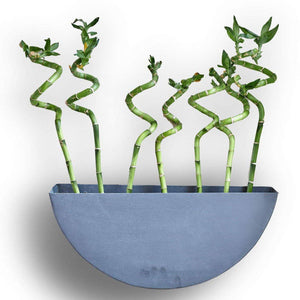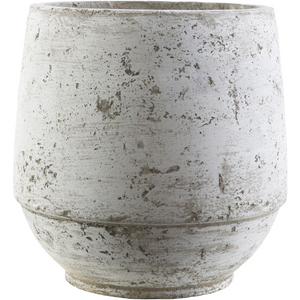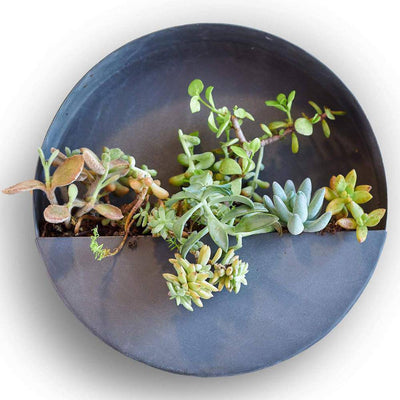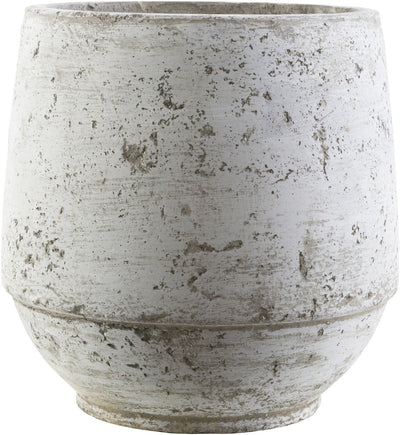Ceramic + Terracotta Planters- Handmade planters and pots using clay and earth, baked in kiln and under the sun
Terracotta vs Ceramic vs Plastic planters- Which is the best option for you?
Ceramic or terracotta, plastic or terracotta. It doesn’t matter what you call them, planters are a staple of home and garden decorating. And for good reason: no matter your style, they are functional and beautiful. They come in a vast array of colors and sizes, which can complement just about any sort of decor. But while they may seem very much alike, they do have their differences. Let’s look at some of the key features and benefits of ceramic, terracotta and plastic pots along with some gorgeous houseplants that work well in each.
-
Terracotta- Terracotta is easily the most recognizable material in the world of plant pots. You’ve probably seen hundreds of these rust-colored clay pots over the years. The reason to choose a terracotta planter is that it is made of a natural and porous material. Being porous, it lets water and air move freely though them (which is great for some plants). The material used is non-toxic and bio-degradable. Using clay makes it sustainable for the environment.
It’s a great fit if you are growing tropical plants , flowering plants like rose, marigold, lilies, orchids, other plants like cacti, succulents, peperomias, pileas, foliage plants , herbs. All of these plants prefer periods of dryness before their next drink of water. This mimics the natural rhythm of rain and sunshine they’d find in their native environments. Well suited for hardy plants.
The drawbacks are the need for frequent watering as the soil dries out much faster, more easily broken.
-
Ceramic- If you were to place an unglazed ceramic pot next to a terracotta one, you might think they’re the same thing. After all, you could paint a terracotta pot and get the same effect. At first glance, pots glazed with a lacquer coat look very similar to unpainted terracotta. But you’d be wrong in thinking they are the same thing as a ceramic pot also contains a glaze and is typically coated with a lacquer sealant. This coating serves to protect the pot plus control water evaporation. It also makes excess moisture less likely to wick through the walls of the planter (if it did, it would collect at the bottom and create puddles). Pots without drainage holes are not advisable since water may sit in them and become a potential breeding ground for mosquitoes and other pests that could harm your plants. Other pots may also contain lead which could leach into your soil negatively affecting your plants as well as yourself if consumed. On the whole a terracotta plant is a better option, but for certain plants a ceramic pot is a great fit too. The best houseplants for ceramic pots are ones that prefer evenly moist soil—generally, ones that have adapted from damper environments in nature.
One of the reasons why ceramic planters are so popular is because they are designed in multiple shapes, are very colorful and attractive in comparison to terracotta.
The plants that are a good fit for ceramic pots are succulents, spider plants, baby’s tears, ferns, golden pothos and more.
-
Plastic - Plastic pots are very popular because of their availability in a wide array of shapes, colors and sizes. They are highly affordable, and the variety is mind boggling. They are light and can be easily moved. However, your plant may not love it too much because of the fact that it has zero breathability and is non-porous. The root structure of a plant requires a certain amount of breathability. We do not recommend plastic pots for succulents as they have a shallow root system. Moisture is trapped in the soil when succulents are planted into pots that are non-breathable and the plant may start to rot.
For plants with a shallow root structure, plastic pots can be used by mimicing the soil layers. Start with gravel of varying size, with a layer of coarse sand & perlite and the top layer of potting soil. This creates a natural drainage system, however then we need bigger pots as well to accommodate al the layers.
If opting for plastic, it is a good idea to go in for polyresin pots.
-
Concrete -Concrete pots and especially those made out of cement are a good option because unlike ceramic pots they do allow some air and water through. Other advantages are they are available in large sizes, making it easy to grow bigger plants.
FAQs
A lot of people ask if ceramic planters are good for houseplants. Ceramic flowerpots are popular for indoor potted plants because they’re cheap and visually attractive. Many houseplants will do well in them, as long as you choose ones that thrive in an evenly moist environment. There are ceramic pots that come with drainage holes. But even with drainage holes, the glazes on ceramics will still cause these pots to retain more moisture than unpainted terracotta pots. If you have ceramic pots with drainage holes, be sure to place a cachepot tray or dish underneath to catch the water drained. The best earthen pots are the ones made out of terracotta because they drain faster than other materials, are weather-resistant, and can handle a wide range of soil types.
Clay pots are popular for indoor and outdoor plants because of their natural looks and weight, but more specifically, they make excellent containers for most types of plants. Clay pots are porous and allow water to seep through the sides. This can be beneficial because they do not collect standing water like plastic pots, which promotes proper draining. Clay pots also tend to retain more humidity than plastic and other materials due to their being porous.
Clay pots are ideal for big plants, and being porous are excellent for bromeliads, cacti, ferns, orchids, and succulents. Clay pots require more frequent watering and are challenging to clean.
Container plants need well-draining soil, and are more vulnerable to fungus and rot if they sit in water. A drainage layer is therefore a must-have when you’re using a container-grown plant indoors. It keeps water from the soil, helps it to dry out faster, and prevents roots from rotting. Line a drainage saucer with a layer of pebbles, gravel or sand, which allows the container to drain freely and prevents the bottom of the pot from standing in water.
If the indoor pot has drainage holes it is better to put a dish or tray under it to catch drained moisture. Another option is a cachepot which is a planter without a hole (cachepot is French for to hide a pot), but comes with its built-in tray.
If you were to place an unglazed ceramic pot next to a terracotta one, you might think they’re the same thing. After all, you could paint a terracotta pot and get the same effect. At first glance, pots glazed with a lacquer coat look very similar to unpainted terracotta. But you’d be wrong in thinking they are the same thing as a ceramic pot also contains a glaze and is typically coated with a lacquer sealant. This coating serves to protect the pot plus control water evaporation. It also makes excess moisture less likely to wick through the walls of the planter (if it did, it would collect at the bottom and create puddles). Pots without drainage holes are not advisable since water may sit in them and become a potential breeding ground for mosquitoes and other pests that could harm your plants. Other pots may also contain lead which could leach into your soil negatively affecting your plants as well as yourself if consumed. On the whole a terracotta plant is a better option, but for certain plants a ceramic pot is a great fit too. The best houseplants for ceramic pots are ones that prefer evenly moist soil—generally, ones that have adapted from damper environments in nature.
Glazed ceramic pots and plastic ones are similar in that they do not dry out quickly, and do not allow air to flow in and out freely.. Plastic pots work best for people who forget to water their plants often and plants that require frequent watering or their roots can remain water logged without damage. These pots help prevent drying out by retaining the excess moisture and wetting the plant’s roots for long. Choosing which type of pot is best for you and your plant will depend on what your plant needs and how much time you have to tend it. On the whole , the plants’ longevity in both ceramic and plastic pots is not significantly different.
When designing terracotta or ceramic planters, it is important to consider the mechanics of water drainage. Most plants require a constant supply of oxygen and a release of carbon dioxide, as well as a measure of water and nutrients. A plant in a pot that has no drainage holes may not be getting the amount of oxygen it needs, because excess water from rain or watering will sit in the pots' crowns and act as a barrier to oxygen exchange. Plants in pots without drainage holes are prone to becoming overwatered, even if the soil surface appears dry. Excess water will eventually pool in the bottom of the pot and rot roots if left unchecked. Therefore ceramic pots with drainage holes are preferable to ones without drainage holes.
Succulents do very well in ceramic pots, unlike many other plants. Since succulents have their inbuilt efficient water storage systems, ceramic pots are top choice for growing them. There are two types of ceramic pot, unglazed and glazed.
The unglazed ceramic pots are quite similar to the terracotta pots. The big difference between them is that the material is less breathable. The clay used is finer, firing happens at a higher temperature. Sand makes material breathable and less sand is used here. Because ceramic pots are less breathable, they will retain moisture. You do not have to water succulents as frequently as with terracotta.
The glazed ceramic pots are usually made out of similar materials to the options mentioned above. However, the pot is less breathable because of the extra glazed coating. Its appearance is also changed, making it glass-like. These glazed pots are also good for succulents but you need to be more attentive with the growing medium and watering.















